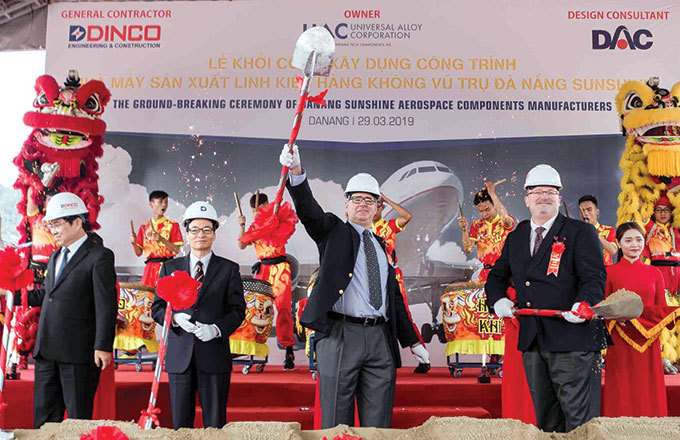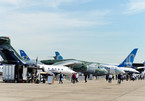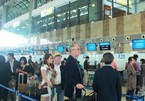 |
The US-based Universal Alloy Corporation (UAC), one of the world’s leading avionic manufacturers, kicked off construction of the $170 million Sunshine aerospace parts factory at the Da Nang Hi-tech Park in March.
The factory is not the first of its kind in Vietnam, as other multinational groups have also set up aircraft component factories here, but is it further proof that Vietnam is embracing the opportunity to become an aircraft component center?
Destination of appeal
UAC’s facility in central Da Nang city will produce and install over 5,000 unique aerospace components made from aluminum alloys and composites for Boeing aircraft, primarily for the fuselage, and all will be exported.
As a sole supplier, it is critical these parts be delivered on time and with the requisite quality. The corporation’s investment in Vietnam is approximately 40 per cent of its total in 2019 and 2020, setting a manufacturing footprint on over 6ha within its 17-ha site at Da Nang Hi-tech Park.
All products will be exported to the global aerospace industry. UAC will begin exporting a planned $80 million worth of products each year after the first phase of the facility comes online between 2021 and 2022 and it expects this to grow to $180 million per year by 2025.
To put this in perspective, UAC will ship five 12-meter ocean containers of aerospace parts per week to North America, Europe, and Asia by 2022.
It also hopes export volumes will double between 2022 and 2025 as the facility further expands. “By 2022, the Da Nang facility will contribute approximately 20 per cent of UAC’s global turnover,” Mr. Kevin Loebbaka, COO for UAC Europe and Asia, told VET.
“With future planned growth in composites and additional metallic aerospace components, this turnover percentage will approach 25 per cent. The factory in Da Nang will be a significant operating location over subsequent decades.”
Late last year, South Korean conglomerate the Hanwha Group, the only aviation engine manufacturer in South Korea, opened its first aircraft component factory at Hanoi’s Hoa Lac Hi-tech Park.
Similar to UAC, Hanwha Aero Engines’ engine components are all for export. The $200-million factory turned out its first products earlier this year.
Prior to Hanwha, aircraft component manufacturers such as Japan’s Mitsubishi Heavy Industries (MHI) and Nikkiso and the US’s General Electric (GE) had already started manufacturing aircraft components in Vietnam.
Mega global trends, such as economic power shifting towards the East, are resulting in more competition among aircraft manufacturers, according to Mr. Paul Tonkes, Director of Industrial and Logistics Services at Cushman & Wakefield (C&W) Vietnam.
MHI, through its subsidiary MHI Aerospace Vietnam (MHIAV), has been assembling inboard flaps and doors for Boeing since 2014.
Its compatriot, Nikkiso, produces aircraft doors with carbon fiber compounds for Boeing 777s in northern Hung Yen province and has also announced plans to expand its investment, as it was selected by Airbus to produce components for its bestselling A320 aircraft.
Moreover, Airbus sent a letter to the Vietnamese Government last year regarding plans to cooperate with the country in developing an aviation industry by setting up a production center together with one of its industry partners.
This would be the only facility in Southeast Asia specializing in producing electric safety belts for use on Airbus A320s. A process of material management, production, examination, and hand-over will be implemented by the European manufacturer.
Why Vietnam?
Vietnam will become an increasingly important supplier of aerospace products in the years to come as aviation sales in the region increase, according to Mr. Loebbaka. The country is uniquely positioned for two key reasons.
The first is the fact that the industry’s key OEMs such as Boeing and Airbus face increasing pressure to manufacture aerospace components in Asia to satisfy offset arrangements for the regional purchase of aircraft.
Deloitte has estimated that some 38,000 aircraft will be produced in the next 20 years to satisfy increasing global demand.
Today, Asia-Pacific countries represent just over 30 per cent of Boeing and Airbus’s order backlog, which translates into the production of more than 12,000 aircraft to satisfy projected Asian passenger traffic.
Secondly, Vietnam is also well-positioned based on the technical capabilities of its workforce. The country has clearly developed its science, technology, engineering, and math (STEM) curriculum, which are well-suited to managing the production of highly-engineered aerospace components.
“Our experience thus far has found that Vietnam has a highly attentive and dedicated workforce,” Mr. Loebbaka said.
Aviation passenger traffic is increasing in Asia, boosted by the region’s growing economies. Air travel demand in the Asia-Pacific region is projected to surpass that of North America and Europe combined in the near future.
Vietnam’s airlines are therefore poised to grow both in the regional transportation market and in direct flights to the US, following approval from US regulators.
This is evidenced already by Vietnam Airlines, Vietjet Air, and Bamboo Airways announcing purchases of over 110 aircraft from Boeing - 65 Airbus A320s and A321s for Vietjet and six aircraft for Bamboo Airways.
“Vietnam will continue to develop aerospace production as Vietnamese airlines continue to increase sales,” he noted.
Vietnam’s “golden” population structure, stable geopolitical environment, and regionally-competitive incentives have helped it emerge as an alternative market, according to Mr. Tonkes.
“The China+1 model seems to be highly effective in deploying and supporting the growth of Maintenance Repair and Overhaul (MRO) centers, and this in turn will help attract investment. Vietnam has also signed 16 free trade agreements, eleven of which are in effect, which play a significant role in attracting foreign investment. These are also helping develop intellectual property (IP) protection, human rights, and tax / customs reform.”
Major constraints
Aviation is a conditional business in Vietnam under Decree No. 92/2016/ND-CP, which covers the field of civil aviation, including air transportation, airport operations, training services, aircraft engine development, and other airport services such as aviation maintenance.
Due to administrative hurdles, it takes three to four years to set up an aviation company in the country.
There are also numerous opportunities in related fields, such as infrastructure, MRO services, engineering, and ICT.
In the aviation manufacturing field, Mr. Tonkes said, there is specifically a shortage of highly-skilled workers and MRO.
The MRO industry, however, has begun to attract attention from young Vietnamese professionals, with increasing numbers sitting entrance exams.
Regarding supply chains, there are challenges in terms of quality, response times, and capacity. An example of this is seen with high-quality powder coating. There is a lack of companies creating prototypes, and there are major concerns with transparency in terms of where suppliers are located, Mr. Tonkes noted.
Another vexing issue that is not unique to aviation is compliance, according to Mr. Fred Burke, Managing Partner at Baker & McKenzie Vietnam. International buyers who look for Vietnamese suppliers, especially small and medium-sized enterprises (SMEs), often find during their vendor due diligence that the suppliers are not in compliance with the strict letter of Vietnam’s labor, tax, or customs laws.
This can kill an opportunity for a local company that wants to sell directly to an international customer.
At the same time, international suppliers who have dealt with major global buyers for many years understand these strict compliance standards and are carefully set up to meet them.
For investors, credibility and clarity are important, Mr. Trent Davies, Manager of International Business Advisory at Dezan Shira & Associates, said.
Vietnam will need to continue to refine its business and investment environment through improving its institutions and reforming the legal framework and investment regulations.
For example, dispute resolution and enforcement and IP protection remain key concerns for investors in the country.
Further, as Vietnam is traditionally a low-value add manufacturing destination, investors struggle to find quality supply chains for components and processes that are similar to those found in China.
In advanced manufacturing, foreign investors encounter skills gaps and Vietnam will need to invest more into education to increase workplace productivity and upskill workers.
Finally, he added, as cost pressures rise in major cities it will be important for Vietnam to continue to invest in infrastructure such as ports, road and rail, as well as industrial land, which is beginning to fill up.
Another key challenge will be acquiring the skill sets for Vietnam to compete with its neighbor, Thailand, which has an advanced automobile manufacturing industry that is attracting a range of aircraft component manufacturers. VN Economic Times
Hung Cao

Vietnam to host int’l aviation expo 2019 for first time
The year 2020 will mark 65 years of Vietnam`s civil aviation industry which has developed rapidly in the past decade with 10 airports capable of serving international flights and 12 domestic airports.

Vietnam aviation sector growth slows
The air travel market grew in the first half of this year, however the growth rate slowed down compared to the same period last year, according to the Civil Aviation Authority of Vietnam (CAAV).
 Vietnam has become increasingly appealing to global aerospace component manufacturers given the favorable internal and external conditions.
Vietnam has become increasingly appealing to global aerospace component manufacturers given the favorable internal and external conditions.